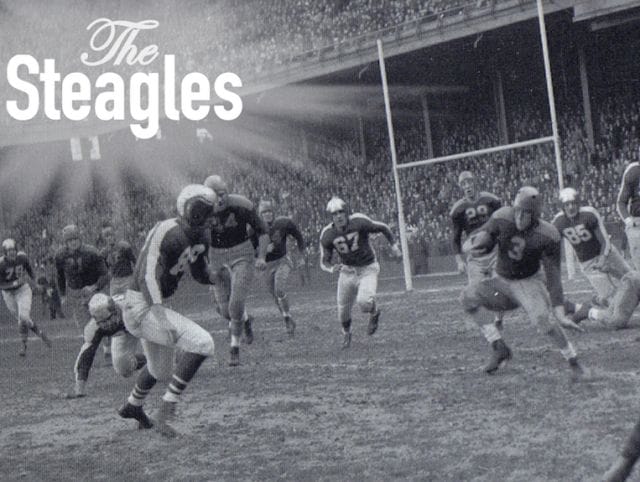
![]()
On December 8, 1941, the day after Japanese forces attacked Pearl Harbor, President Roosevelt delivered his famous “Infamy” speech to a radio audience of 100 million Americans. Thirty-three minutes later, Congress officially declared the United States’ entry into World War II.
The previous year, the U.S. Government had signed into law the Selective Training and Service Act, which required all men between the ages of 21 and 36 to register for one year of military service, as selected by a national lottery. Following Pearl Harbor, this act was amended: eligible ages expanded from 18 to 64, and the required service became “the duration of the war, plus six months.”
By the end of 1941, nearly two million men had been conscripted for service, and another 200,000 willingly volunteered — including some of the biggest sports stars in America. As teams’ rosters diminished in size, a serious question arose: should professional sports continue during a time of conflict and war?
Major League Baseball’s then-commissioner, Kenesaw Landis, had the same question. In the early months of 1942, he wrote to President Roosevelt inquiring whether or not baseball should be temporarily discontinued; in response, the President sent what has since become known as the “Green Light Letter:”
A portion of President Roosevelt’s “Green Light Letter”
Roosevelt’s decision to keep baseball going in order to boost morale on the homefront was interpreted by other commissioners as applicable to their sports as well. Like baseball, the National Football League (NFL) stayed in business, and kicked off the season in September of 1942.
Though the NFL persisted, the sport was seriously impacted by the war effort: by the time the 1943 season began, some 600 players and coaches — more than half of the entire league — had joined the armed forces. As a result, the Cleveland Rams, which had lost not only most of its players, but its majority owner to the draft, suspended play for the season, leaving an uneven 9 teams in the NFL, many of which were shorthanded.
As a result, one of the strangest things in NFL history happened: two interstate rival teams — the Philadelphia Eagles and the Pittsburgh Steelers — were merged. The result? A gaggle of World War Two draft rejects dubbed the “Steagles.”
***
At the onset of the 1943 season, neither of Pennsylvania’s two NFL teams were in good shape. The Philadelphia Eagles had only 16 players (about 50%) left on their roster, and the Pittsburgh Steelers fared even worse, with a mere 6 remaining. Each team had relied on the 1943 NFL Draft for replenishment, but the vast majority of NFL draft picks were instead drafted for the war.
The Steelers’ owner, Art Rooney, knew that if he didn’t act quickly, he’d have to withdraw his team from the league for a lack of players. His plan, to merge the Steelers with the Eagles, was initially met with incredulity, especially by the Eagles’ owner, Alexis Thompson, who, at the time, was serving as a corporal in the US Army. Eventually, the two came to a mutual consensus: the two teams were combined, and debuted as simply the “Eagles,” and later, as “Phil-Pitt Combine.” Soon though, the media had christened them the “Steagles.”
“It sounds like we had a big advantage, putting two teams together as one,” Steagles tackle Al Wistert later said, “but all it meant is that we had twice as many lousy players.”
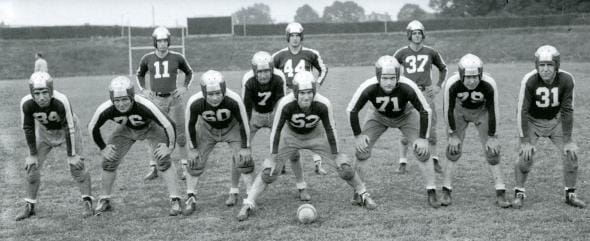
Members of the 1943 Steagles
The Steagles, which The New York Times called a “horribly named hybrid monstrosity,” sported a less than impressive lineup, largely made up of the players who’d been rejected from the military draft.
The Selective Service, which approved men for the draft through a series of interviews and health tests, had a number of numerical categories by which a draftee could be rejected, including 4-F (“Men physically, mentally or morally unfit to serve”), and 3-A (“A father whose child was born or conceived prior to the attack on Pearl Harbor”). Of the 30 players on the Steagles’ roster, a whopping 16 were deemed to be 4-Fs, while 6 more were 3-As. Overall, 22 of 30 players were rejected for military service.
“There were guys with bad eyes, bad knees, bad backs, punctured eardrums — things that could get you out of service, but not an NFL game,” retired player Joe Horrigan told ESPN. “A manpower shortage caused teams to hire players who were old, overweight, not otherwise qualified to be professional athletes.”
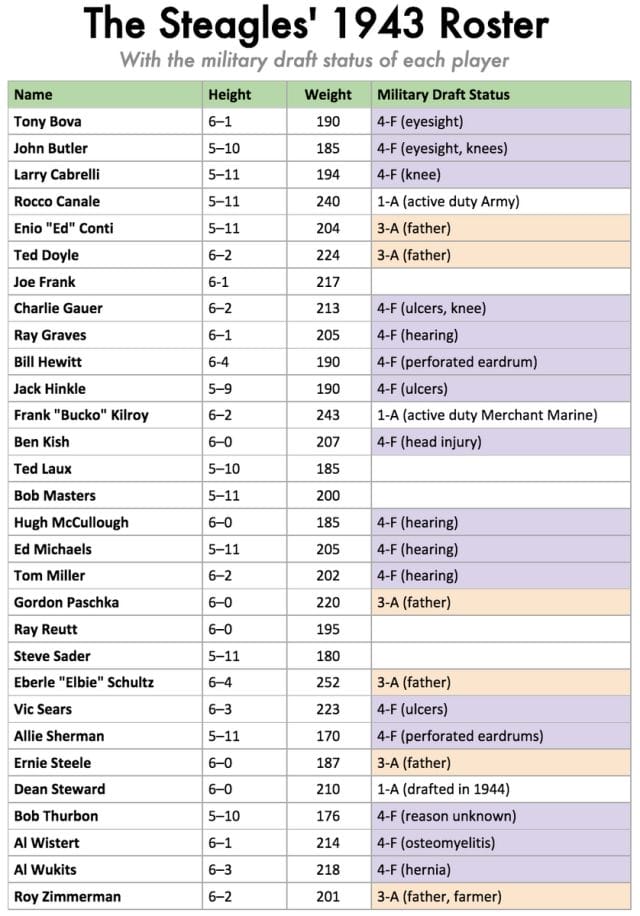
Generally, most players in the NFL wanted to join the war: opting out, whatever the reason, was perceived as unpatriotic and cowardly — and being categorized as a 4-F was considered demeaning. Players were scrupulously questioned by fans: how could a man be physically fit enough to play football, yet not serve his country?
Bill Hewitt, who was excused from military service for a “perforated eardrum” and served as the Steagles’ defensive end during the 1943 season, was so guilt-ridden that he quit the team mid-season, and went to go work in a milk factory.
Other Steagles players faced more pressing medical problems: Tony Bova, the receiver, “was completely blind in one eye and partially blind in the other. Two of his teammate, Ed Michaels and Ray Graves, were entirely deaf in one ear. John Butler, who, as tailback, was required to run dozens of offensive lines per game, had arthritis in his knees. In a wide variety of respects, the Steagles team was riddled with ailments.
Added to this, nearly every player on the team held a second job in the defense industry, producing weapons, ammunition, and other materials during the season. Allie Sherman, the Steagles’ starting quarterback during the 1943 season, recalls the struggle of balancing practice and industry work:
“We had to practice in the evenings, and a number of the men had wartime jobs at night. As a result, we would practice with just one set of lights up at the old Shibe Park [the Steagles’ home field]…it got pretty dark there at times.”
Another Steagles player, Ted Doyle, worked at nuclear manufacturer, Westinghouse, and, in a small way, assisted in the creation of the atomic bomb.
As if these pressures weren’t enough, the team had to deal with an extremely polarized coaching staff, comprised of the Steelers’ Walt Kiesling (an old-school former player), and the Eagles’ Greasy Neale (an ex-Yale coach with a penchant for experimentation). “They’re like a cat and a dog,” joked one journalist. “They hate each other’s guts.”
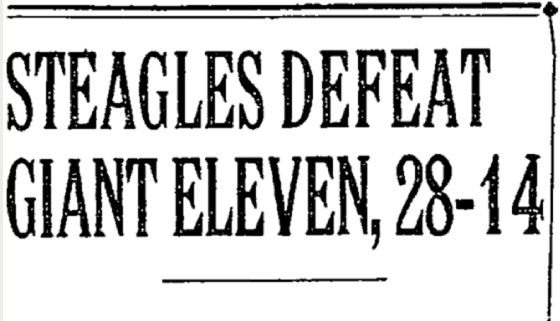
New York Times caption from the Steagles’ second victory (October 10, 1943)
Despite these challenges, the Steagles played surprisingly well: they won their first two games, including a come-from-behind, 28-14 defeat of the heavily favored New York Giants.
“What a disgrace to lost to a bunch of humpty-dumpties like that,” Giant head coach, Steve Owen, lectured his team after the game. “You guys were so lousy that you even let that little squirt from Brooklyn [Steagles quarterback, Allie Sherman] score a touchdown on you.”
By season’s end, the Steagles finished with 5 wins, 4 losses, and 1 tie (a 55.6% winning percentage) — narrowly missing out on tying for first place in the NFL’s Eastern Division. This marked the first winning record in the Eagles’ decade-long history, and just the second for the Steelers. What’s more, the season attendance (229,595) was a record high for both teams.
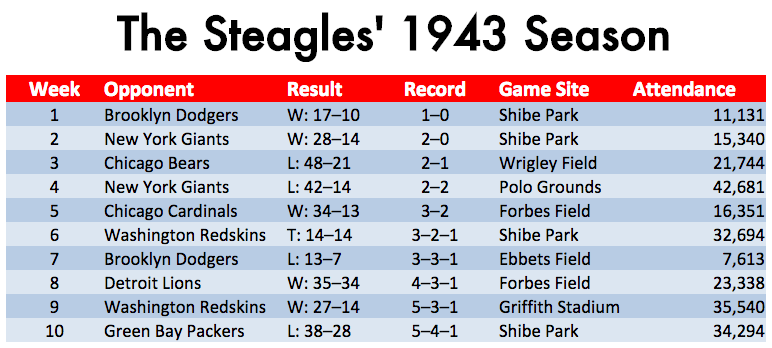
The following season, the Steagles merger was dissolved, and each team went their own way. While the Philadelphia Eagles finished second in the Eastern Division with a 7-1-2 record (the best in their franchise’s history), the Pittsburgh Steelers suffered a much graver fate. Again, they were merged — this time, with the ailing Chicago Cardinals — to form the combine “Card-Pitt.”
In the 1944 NFL season, Card-Pitt “set a benchmark for futility”: they finished the year 0-10 (one of the worst record in football history), and were run over so handily by opponents that they were derided as “The Carpets” by sports journalists. To top this off, they, to this day, retain the lowest punting average in NFL history, with just 32.7 yards per punt.
Eventually, the league returned to normalcy: the Eagles went on to win 3 NFL Championships (the precursor the the Super Bowl), while the Steelers later secured six Super Bowl titles.
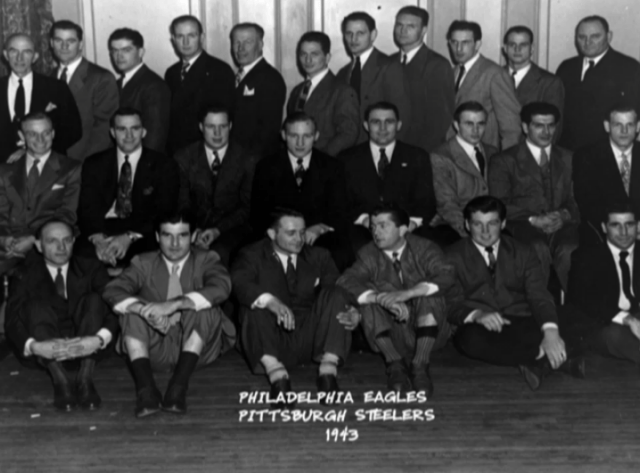
Still, for each team, and for the NFL in general, the briefly-lived 1943 Steagles will always hold a place in history.
“There was a special bond among the Steagles’ 4-Fs, who believed, in some small way, they were contributing to the war effort,” writes Matthew Algeo, in his book Last Team Standing. “If they couldn’t fight the war, at least they could take people’s minds off it.”
Like America at large, the Steagles maximized the resources they had during a time of war. And despite being composed of military draft rejects, the team fully embodied America’s wartime catch-phrase: “We are all in this together.”
![]()
This post was written by Zachary Crockett. You can follow him on Twitter here.
To get occasional notifications when we write blog posts, please sign up for our email list.




